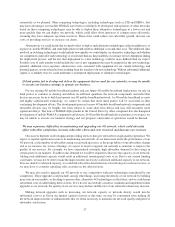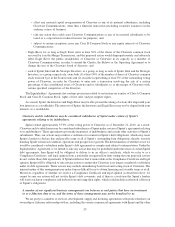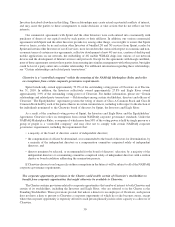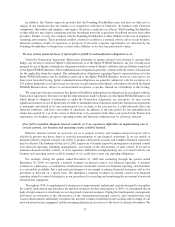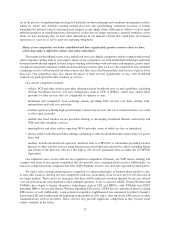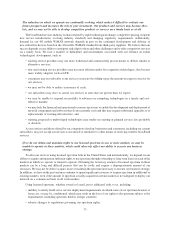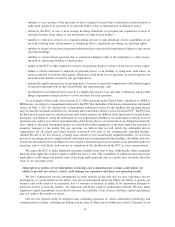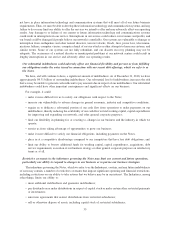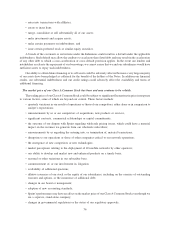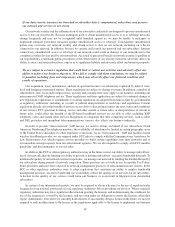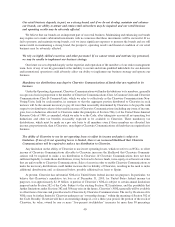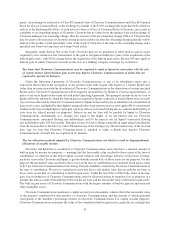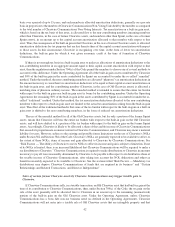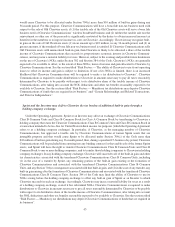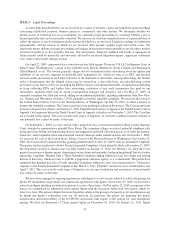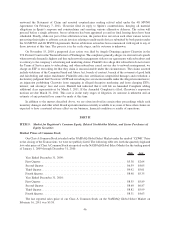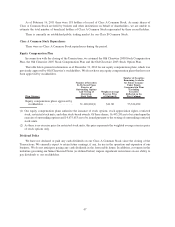Clearwire 2010 Annual Report Download - page 42
Download and view the complete annual report
Please find page 42 of the 2010 Clearwire annual report below. You can navigate through the pages in the report by either clicking on the pages listed below, or by using the keyword search tool below to find specific information within the annual report.• changes in earnings estimates or recommendations by securities analysts;
• announcements regarding mobile WiMAX and other technical standards;
• the availability or perceived availability of additional capital and market perceptions relating to our access to
such capital; and
• general economic conditions and slow or negative growth of related markets.
In addition, the stock market in general, and the market for shares of technology companies in particular, have
experienced price and volume fluctuations that have often been unrelated or disproportionate to the operating
performance of those companies. We believe the price of our Class A Common Stock may be subject to continued
volatility. In addition, in the past, following periods of volatility in the trading price of a company’s securities,
securities class action litigation or stockholder derivative suits have often been instituted against those companies.
Such litigation, if instituted against us, could result in substantial costs and divert our management’s attention and
resources.
Certain aspects of our VoIP residential telephony services differ from traditional telephone service, which
may limit the attractiveness of our services.
We intend to continue to offer residential VoIP telephony as a value added service with our wireless broadband
Internet service. Our residential VoIP telephony services differ from traditional phone service in several respects,
including:
• our subscribers may experience lower call quality than they experience with traditional wireline telephone
companies, including static, echoes and transmission delays;
• our subscribers may experience higher dropped-call rates than they experience with traditional wireline
telephone companies; and
• a power loss or Internet access interruption may cause our service to be interrupted.
If our subscribers do not accept the differences between our residential VoIP telephony services and traditional
telephone service, they may not adopt or keep our residential VoIP telephony services or our other services, or may
choose to retain or return to service provided by traditional telephone companies.
Although we are compliant with the FCC’s November 28, 2005 mandate that all interconnected VoIP providers
transmit all 911 calls to the appropriate public safety answering point, our VoIP emergency calling service is
significantly more limited than the emergency calling services offered by traditional telephone companies. Our
VoIP emergency calling service can transmit to a dispatcher at a public safety answering point only the location
information that the subscriber has registered with us, which may at times be different from the actual location at the
time of the call due to the portability of our services. As a result, if our subscribers fail to properly register or update
their registered locations, our emergency calling systems may not assure that the appropriate public safety
answering point is reached and may cause significant delays, or even failures, in callers’ receipt of emergency
assistance. Our failure to develop or operate an adequate emergency calling service could subject us to substantial
liabilities and may result in delays in subscriber adoption of our VoIP services or our other services, abandonment of
our services by subscribers, and litigation costs, damage awards and negative publicity, any of which could harm our
business, prospects, financial condition or results of operations. In addition, our deployment of mobile intercon-
nected VoIP services faces additional E911 regulatory uncertainty, as discussed in the “Business — Regulatory
Matters — Interconnected VoIP Services Regulation” section of this filing.
Finally, potential changes by the FCC to current intercarrier compensation mechanisms could result in
significant changes to our costs of providing VoIP telephony, thereby eliminating pricing benefits between VoIP
telephony services and traditional telephone services and our potential profitability.
37


